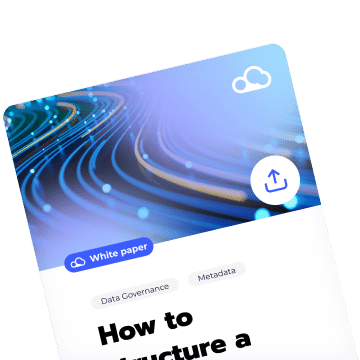What’s the difference between a best-selling novel and a spreadsheet stuffed with data? You might actually want to read the novel. Jokes aside, the universal appeal of a well-crafted story captures our attention and imagination, not raw data.
The power of a good story is transformative, especially for data literacy. When weaved with a compelling tale, lifeless numbers begin to take on meaning and even provide answers to real-world problems. This point is crucial in our modern, data-saturated world.
The role of narrative techniques in simplifying data concepts
Narrative techniques turn dry, complex data into engaging stories for a broader audience. This approach can suit a company’s non-technical units and be an effective tool for any audience.
To illustrate, let’s review a practical example that showcases how narratives can provide meaningful and actionable insights.
A hospital administrator shares how her medical practice reduced re-admission rates by 25%. Rather than citing a long string of dates, digits, and other data to her team, she crafts a story around two fictional patients, Taylor and Joe.
The administrator’s story explains how, before release, Taylor received a personalized care plan that included customized medication schedules, in-home care, and follow-up visits with her doctor, while Joe experienced the usual hospital discharge procedures.
In the administrator’s story, Taylor and Joe represent the outcomes of different patient care approaches. With her personalized plan, including in-home care and prompt follow-ups, Taylor showcased the effectiveness of tailored healthcare, as her re-admission rate dropped to 5%, while Joe’s remained unchanged.
By humanizing data through Taylor and Joe’s stories, the hospital administrator makes the complex data on re-admission rates relatable and impactful. The staff is informed and emotionally engaged, underscoring the importance of individualized patient care in reducing re-admissions. This narrative approach transforms statistics into a powerful motivator for adopting personalized care strategies.
Other effective narrative techniques
- Analogies & metaphors: These figures of speech draw parallels between abstract concepts and familiar ideas to create a mental bridge between the known and the unknown, making the abstract easier to understand. For example, comparing the spread of a disease to a wildfire instantly conveys the uncontrolled nature of the situation and imparts a sense of urgency and need for immediate action.
Similarly, comparing investment growth to planting a seedling depicts long-term investment strategies. This metaphor aptly communicates the idea of making a small investment and watching it grow over time.
- Sequential storytelling: Sequential storytelling describes a series of events over time, transforming isolated data points into a cohesive and chronological narrative.For instance, this technique might be used to trace a product’s journey from its initial retail launch to its rise to market dominance.
The story begins with the product’s initial sales data and then moves on to how a subsequent marketing campaign influenced sales. Following this, the narrative includes product enhancements, such as new colors and sizes, and the resulting market and sales data for each upgrade. In this way, each data point along the timeline contributes a piece to the overall story, clearly illustrating the cumulative impact of each decision and change on the product’s success.
- Contextualization: Contextualization is vital for business units, which often engage less with technical data than other departments. This approach translates data into relatable scenarios and stories that align with their experiences and job responsibilities, integrating data into their operational narrative. Such contextualization is crucial when onboarding teams into data governance programs, as it bridges the gap between their everyday experiences and the abstract nature of data.
For example, consider a scenario where a sales team is introduced to a new data governance program. The training might begin with a narrative based on a recent sales campaign using actual sales data to demonstrate how issues like duplicate customer records led to miscommunication and missed opportunities. The story then shows how implementing data governance protocols, emphasizing data cleaning and maintenance, could have averted these problems.
This narrative approach further illustrates how enhanced data governance can lead to more accurate sales forecasting and improved customer relationship management. By walking the team through a realistic scenario, the concept of data governance is made tangible and directly relevant to their roles, aiding their understanding of its importance and practical applications.
Additionally, by presenting data in a context that resonates with the everyday roles of business unit members, they are more likely to retain this information and grasp its significance. This leads to more informed decision-making and a deeper appreciation of the data governance program. Ultimately, the narrative enhances the effectiveness of the entire initiative.
Targeting narratives to specific roles
Role-specific storytelling targets data narratives to specific roles and functions, enhancing understanding and application. For instance, a marketing manager in a retail company might focus on customer engagement metrics and market trends, which are crucial for their role. They may begin with an overview of a recent marketing campaign’s impact on online engagement, revealing how different demographics responded. This approach indicates, for example, that younger audiences are more engaged on social media and older demographics show higher interaction rates via email.
Through such a narrative, the marketing manager comprehensively understands the raw data and its underlying trends, turning abstract numbers into meaningful insights and enhancing their data literacy and utilization.
Strategies like role-play scenarios or case studies specific to business functions are invaluable when transitioning into broader team onboarding. For a sales team in a data governance program, narratives could revolve around customer acquisition trends and sales performance. Conversely, the focus for a supply chain team might be on inventory management data and logistics efficiency, making data governance concepts directly applicable to their daily tasks.
Contextualization, therefore, is key in making data meaningful by transforming sterile numbers into engaging stories and scenarios. Let’s delve into how these strategies can boost knowledge and decision-making across various business units.
Fostering data literacy through narrative engagement
Incorporating narrative into data literacy initiatives can significantly increase an organization’s effective use of data. Let’s explore actionable ways to leverage narrative through literacy initiatives:
- Integrating storytelling in training modules: Use realistic case studies.
- Interactive data narratives: Create interactive experiences where learners can navigate through stories at their own pace.
- Role-playing and scenario-based learning: Encourage learners to participate in role-playing exercises.
- Use of visual storytelling: Leverage visual storytelling tools like infographics and data visualizations. These tools can turn complex data sets into clear, engaging stories that are easy to understand and remember. For example, an infographic on patient recovery rates offers healthcare managers a visual record of healthcare outcomes rather than a dry table filled with numbers.
- Storytelling workshops: Conduct workshops to develop data narrative proficiency.
- Cognitive influence of storytelling: Acknowledge and employ the mental aspects of storytelling. Narratives help form mental models, making it easier for the brain to process and remember information. By framing data within stories, learners better comprehend and recall complex information.
Narrative engagement dynamically enhances data literacy. It renders data understandable, memorable, and actionable, transforming numbers into informative, persuasive, and inspiring stories.
Conclusion
Integrating narrative techniques is a powerful catalyst for understanding and engagement: It transforms abstract numbers into influential narratives by personalizing data, leveraging visualization, and weaving context-rich stories. These techniques simplify complex concepts, enhance decision-making and retention, and promote data literacy.
____________________
Discover the benefits of creating an intuitive data catalog to fit your needs! Book a demo of DataGalaxy’s Data Knowledge Catalog, an all-in-one tool that offers out-of-the-box actionability with fully customizable attributes, powerful visualization tools, and AI integration to help organizations easily document, link, and track all their metadata assets on one dynamic platform.





